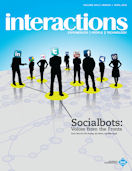Authors:
Leanna Gingras
The job of a user-research professional is undoubtedly a hard one. Understanding problems, getting the right sample of people in our labs, extracting insights from data, and evangelizing the user's needs can make for challenging work. At the same time, rewards abound in this profession: the joy of diving into a new topic, engrossing conversations with some of the hundreds of people who pass through my lab, and of course the aha momentsthose glimmers of awesomeness alone more than make up for any difficulties. But every now and then I wish it were all a little...easier. In the heat…
You must be a member of SIGCHI, a subscriber to ACM's Digital Library, or an interactions subscriber to read the full text of this article.
GET ACCESS
Join ACM SIGCHIIn addition to all of the professional benefits of being a SIGCHI member, members get full access to interactions online content and receive the print version of the magazine bimonthly.
Subscribe to the ACM Digital Library
Get access to all interactions content online and the entire archive of ACM publications dating back to 1954. (Please check with your institution to see if it already has a subscription.)
Subscribe to interactions
Get full access to interactions online content and receive the print version of the magazine bimonthly.







Post Comment
@Bill Killam (2012 07 31)
This is a long overdue article. And I couldn’t agree with it more. I’m current working on yet another Federal RFP that is asking for us to do work using short cut methods that are likely make it harder to get them quality results, and we can probably propose a cheaper and more data rich approach if they didn’t specify how we had to do the job. Sad.